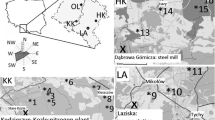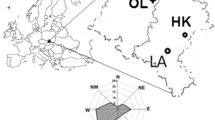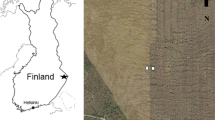Abstract
Carbon isotope analyses of peat profiles from the Karkonosze Mts. (SW Poland) and tree-ring cellulose from Wisła river valley in the Kraków region (S Poland) have been carried out. The samples analysed represent approximately the last 1100 years.The δ13C profile in peat from the Szrenica peat bog ranges from -26.74 to -21.81‰ and the δ13C value of tree rings range from -27.82 to -21.94 permil. The observed variations in the δ13C values of the peat samples and tree rings from Poland in general correlated with each other (Figure 1). This suggests that the δ13C value of organic matter in terrestrial conditions is generally controlled by the same environmental factors. On average, over the last millennium (X-XIX century), the δ13C value of peat cellulose has been 1.8‰ isotopically heavier compared to the corresponding tree ring cellulose value.It is not possible to provide a precise calibration of isotope signatures in tree rings, as the assimilation isotope effect depends mostly on local microclimatic conditions and specific species demands. In the region under study, temperature was the dominant factor controlling the δ13C value of tree ring cellulose and peat-bog Sphagnum before the XIX century. It is estimated that, in the temperate climate of Poland, the carbon isotope fractionation between living plants and atmospheric carbon dioxide (Δ13Cp-a) for C3 plants is about -0.26‰/1 °C. This corresponds to 2.1‰/1000 m of elevation. Since the mid-XIX, in the Wisła valley when the river was regulated and water deficit in the neighbouring areas became common (Trafas, 1975), water availability plays a primary role in isotope fractionation of the vegetation. Since the 1955, just after the `Lenin' steelworks started operation, pollution became the dominant factor controlling the carbon isotope signature of plants. Contamination of the atmosphere by fossil fuel burning from the `Lenin' steelworks increased the δ13C value of tree ring cellulose by about 1.3‰. This was probably caused by an increased concentration of atmospheric pollution (SOx and dust) limiting the ventilation rate of the stomata.
Similar content being viewed by others
References
Barber, K. E.: 1981, Peat Stratigraphy and Climatic Change, A.A. Balkema/Rotterdam.
Becker, B., Kromer, B. and Trimborn, P.: 1991, ‘Stable isotope tree-ring timescale of the Late Glacial/Holocene boundary’ Nature 353, 647-649.
Brenninkmeijer, C. A. M.: 1983, ‘Deuterium, Oxygen-18 and Carbon-13 in Tree Rings and Peat Deposits in Relation to Climate’ Ph.D. Thesis, Rijksuniversiteit te Groningen.
Brenninkmeijer, C. A. M., Van Geel, B. and Mook, W. G.: 1982, ‘Variations in the D/H and 18O/16O ratios in cellulose extracted from a peat bog core’ Earth. Planet. Sci. Lett. 61, 283.
Bruckner, G., Gebauer, L. and Schulze, E.-D.: 1993, ‘Uptake of 15NH3 by Picea abies in closed chamber experiments’ Isotopenpraxis Environ. Health Stud. 29, 71-76.
Buhay, M. W. and Edwards, T. W.: 1993, ‘Reconstruction of Little Ice Age climate in Southern Ontario, Canada, from Oxygen and Hydrogen Isotopes in Tree Rings’ in: Proceedings of a Symposium ‘Isotope Techniques in the Study of past and Current Environmental Changes in the Hydrosphere and the Atmosphere', Vienna, 19-23 April 1993, pp. 407-417.
Climatic Atlas: 1973, PPWK, Warszawa (in Polish).
Dupont, L. M. and Brenninkmeijer, C. A. M.: 1984, ‘Paleobotanic and Isotopic Analysis of the Late Sub-Boreal and Early Sub-atlantic Peat from Engbertsdijksveen VII, The Netherlands’ Review of Paleobotany and Palynology 41, 241-271.
Edwards, T. W. and Fritz, P.: 1986, ‘Assessing meteoric water composition and relative humidity from O and H in wood cellulose: Palaeoclimatic implications for southern Ontario, Canada, Appl. Geochem. 1, 715-723.
Epstein, S., Yapp, J. and Hall, J. H.: 1976, ‘The determination of the D/H ratio of non-exchangeable hydrogen in cellulose extracted from aquatic and land plants’ EPSL 30, 41-251.
Farquhar, G. D., O'Leary, M. H. and Berry, J. A.: 1982, ‘On the relationship between carbon isotope discrimination and the intercellular carbon dioxide concentration in leaves’ Aust. J. Plant Physiol. 9, 121-137.
Farquhar, G. D., Ehleringer, J. R. and Hubic, K. T.: 1989, ‘Carbon isotope discrimination and photosynthesis’ Annu. Rev. Plant Physiology Plant Mol. Biol. 40, 503-537.
Feng, X. and Epstein, S.: 1995, ‘Carbon isotopes in trees from arid environments and implications for reconstructing atmospheric CO2 concentration’ Geochim. Cosmochim., Acta 59, 2599-2608.
Freyer, H. D.: 1979, ‘On the δ13C record in tree rings. Part II. Registration of microenvironmental CO2 and anomalous pollution effect’ Tellus 31, 308-312.
Freyer, H. D. and Belacy, N.: 1983, ‘13C/12C records in northern hemispheric trees during the past 500 years, anthropogenic impact and climatic superpositions’ J. Geophys. Res. 88, 6844-6852.
Freidli, H., Lötscher, H., Oeschger, H., Seigenthaler, U. and Stauffer, B.: 1986, ‘Ice core record of the 13C/12C ratio of atmospheric CO2 in the past two centuries’ Nature 324, 237-328.
Gebauer, G., Katz, C. and Schulze, E.-D.: 1991, ‘Uptake of Gaseous and Liquid Nitrogen Deposits and Influence on the Nutritional Status of Norway Spruce’ in R. Handschel and F. Bese (eds), Effects of Forest Management on the Nitrogen-Cycle with Respect to Changing Environmental Conditions, GSF Report 43/91, Munchen-Neuherberg, Germany, pp. 83-92.
Gebauer, G., Giesemann, A., Schulze, E.-D. and Jäger, H.-J.: 1994, ‘Isotope ratios and concentrations of sulphur and nitrogen in needles and soils of Picea abies stands as influenced by atmospheric deposition of sulphur and nitrogen compounds’ Plant and Soil, 164, 267-281.
Grinstead, M. J., Wilson, A. T. and Ferguson, C. W.: 1979, ‘13C/12C ratio variations in Pinus longaeva (Bristlecone pine) cellulose during the last millenium’ Earth Planet. Sci. Lett. 42, 251-253.
Hill, S. A., Waterhouse, J. S., Field, E. M., Switsur, V. R. and ap Rees, T.: 1995, ‘Rapid recycling of triose phosphates in oak stem tissue’ Plant, Cell Environ. 18, 931-936.
Hoefs, J.: 1997, Stable Isotope Geochemistry, Springer-Verlag, 201 p.
Hemming, D. L.: 1998, ‘Stable Isotopes in Tree Rings: Biosensors of Climate and Atmospheric Carbon Dioxide Variations’ Ph.D. Thesis, Cambridge University, U.K.
Hemming, D. L., Switsur, V. R., Waterhouse, J. S., Heaton, T. H. E. and Carter, A. H. C.: 1998, ‘Climate variation and the stable isotope composition of tree ring cellulose: an intercomparison of Quercus robur, Fagus silvatica and Pinus sylvestris’ Tellus 50B(1), 25-33.
ę, M. O., Skrzypek, G., Wada, E., Doroszko, B., Kral, T. E., Pazdur, A., Vijarnsorn, P. and Takai, Y.: 1995, ‘δ13C and δ34S analysis in peat profiles, and global change’ Przegl?d Geologiczny 43, 1004-1010 (in Polish, English abstr. and figs.).
ę, M. O., Skrzypek, G., Wada, E., Pazdur, A., Halas, St., Vijarnsorn, P., Takai, Y. and Ueda, S.: 1996, ‘δ13C and δ34S in Peat: Possible Tool for Paleoenvironmental Reconstruction’ in S. H. Bottrell (editor in chief), A. C. Alpin, J. M. McArtur, R. J. Newton, M. Krom and R. Raiswell (assoc. editors), Proceedings Fourth International Symposium on the Geochemistry of the Earth Surface, Ilkley, Yorkshire, England, U.K., 22-28 July 1996, held under the auspices of: The International Association of Geochemistry and Cosmochemistry, pp. 221-224.
ę, M. O., Kr?piec, M., Skrzypek, G., Ka?u?ny, A. and Ha?as, St.: 1998a, ‘An attempt to calibrate carbon and hydrogen isotope ratios in oak tree rings cellulose: The last millennium’ RMZ-Materials and Geoenvironment 45, 82-90.
ę, M. O., Skrzypek, G., Ka?u?ny, A., Kr?piec, M., Halas, St. and Pazdur, A.: 1998b, ‘Paleotemeprature scale, δ13C record in tree rings, δ13C record in a peat core: Why do they correlate?’ RMZ-Materials and Geoenvironment, 45, 99-106.
ę, M. O., Ka?u?ny, A. and Hoefs, J.: 2002, ‘S and O isotope ratios in spruce needles as a tracer of atmospheric pollution’ J. Geophysical Research - Atmospheres (in press).
Kalicki, T. and Kr?piec, M.: 1995, ‘Problems of dating alluvium using buried subfossil tree trunks: Lessons from the ‘black oaks’ of the Vistula Valley, Central Europe’ The Holocene 5, 243-250.
Keeling, C. D. and Whorf, T. P.: 1996, ‘Atmospheric CO2 Records from Sites in the SIO Air Sampling Network’ in Trends: A Compendium of Data on Global Change, Carbon Dioxide Information Analysis Centre, Oak Ridge National Laboratory, Oak Ridge, Tenn., U.S.A.
Korner, Ch., Farquhar, G. D. and Roksandic, Z.: 1988, ‘A global survey of carbon isotope discrimination in plants from high altitude., Oecologia (Berlin) 74, 623-632.
Korner, Ch., Farquhar, G. D. and Wong, S. C.: 1991, ‘Carbon isotope discrimination by plants follows latitudial and altitudial trends’ Oecologia (Berlin) 88, 30-40.
Lamb, H. H.: 1977, Climate: Present, Past and Future, Vol. 2, Methuen, London.
Leavitt, W. and Long, A.: 1986, ‘Stable-carbon isotope variability in tree foliage and wood’ Ecology 67, 1002-1010.
Leavitt, S. W. and Long, A., 1989, ‘The atmospheric δ13C record as derived from 56 Pinyon trees at 14 sites in the southwestern United States’ Radiocarbon 31 469-474.
Levin, I., Kromer, B., Schoch-Fischer, H., Bruns, M., Münnich, M., Bedrau, D., Vogel, J. C. and Münnich, K.: 1996, ‘δ13C Records from Sites in Central Europe’ in T. A. Boden, D. P. Kaiser, R. J. Stepanski and F. W. Stoss (eds), Trends'93: A Compendium of Data on Global Change, ORNL/CDIAC-65, Carbon Dioxide Information Analysis Centre, Oak Ridge National Laboratory, Oak Ridge, Tenn., U.S.A.
Lipp, J., Trimborn, P., Fritz, H., Moser, H., Becker, B. and Frenzel, B.: 1991, ‘Stable isotopes in tree ring cellulose and climatic change’ Tellus 43B, 322-330.
Loader, N. J. and Hemming, D. L.: 2001, ‘Spatial variations in pollen δ13C correlate with temperature and seasonal development timing’ The Holocene 11, 587-592.
Martin, B. and Sutherland, E.: 1990, ‘Air pollution in the past recorded in width and stable carbon isotope composition of annual growth rings of Douglas-fir’ Plant, Cell Environ. 13, 839-844.
Martin, B., Bytnerowicz, A. and Thorstenson, Y. R.: 1988, ‘Effects of air pollutants on the composition of stable carbon isotopes, δ13C, of leaves and wood, and on Leaf Injury’ Plant Physiol. 88, 218-223.
Matthes, F. W.: 1939, ‘Report of committee on glaciers’ Trans. Am. Geoph. Union 1, 518-520.
O'Leary, M. H.: 1981, ‘Carbon isotope fractionation in plants’ Phytochemistry 20, 553-567.
Olszyk, D. M. and Tingey, D. T.: 1986, ‘Joint action of O3 and SO2 in modifying plant gas exchange’ Plant Physiol. 82, 401-405.
Reich, P.B., Schoettle, A. W., Raba, R. M. and Amundson R. G.: 1986, ‘Response of soybean to low concentrations of ozone. I. Reduction in leaf and whole plant net photosynthesis and leaf chlorophyll content’ J. Environ. Qual. 15, 31-35.
Reich, P. B., Schoettle, A. W., Stroo, H. F., Troian, J. and Amundson, R. G.: 1987, ‘Effect of ozone and acid rain on white pine (Pinus strobus) seedling grown in five soils. I. Net photosynthesis and growth’ Can. J. Bot. J. 65, 977-987.
Reinert, R. A.: 1984, ‘Plant response to air pollutant mixtures’ Annu. Rev. Phytopathol. 22, 421-442.
Robertson, I., Rolfe, J., Switsur, V. R., Carter, A. H., Hall, M. A., Barker, A. C. and Waterhouse, J. S.: 1997, ‘Signal strength and climate relationships in 13C/12C ratios of tree ring cellulose from oak in southwest Finland’ Geophys. Resear. Lett. 24, 1487-1490.
Saurer, M. and Siegenthaler, U.: 1989, ‘13C/12C isotope ratios in trees are sensitive to relative humidity’ Dendrochronologia 7, 9-13.
Saurer, M., Siegenthaler, U. and Schweingruber, F.: 1995, ‘The climate-carbon isotope relationship in tree rings and the significance of site conditions’ Tellus 47B, 320-330.
Schleser, G. H.: 1995, ‘Parameters Determining Carbon Isotope Ratios in Plants’ in B. Frenzel (ed.), Problems of Stable Isotopes in Tree-rings, Lake Sediments and Peat-bogs as Climatic Evidence for the Holocene, European Palaeoclimate and Man 10 (Special Issue: Europ. Sci. Found. Project).
Schleser, G. H., Helle, G., Lücke, A. and Vos, H.: 1999, ‘Isotope signals as climate proxies: The role of transfer functions in the study of terrestrial archives’ Quatern. Sci. Rev. 18, 927-943.
Skrzypek, G.: 1999, ‘Isotope Record of Environmental Changes in Selected Upper Holocene Peat Cores from Poland’ (in Polish, English abstract), Ph.D. Thesis, Institute of Geological Sciences, University Wroclaw, Poland.
Stachlewski, W.: 1978, Climate: The Past, Present and Future, PWN, Warszawa, (in Polish).
Stunner, M. and Braziunas, T. F.: 1987, ‘Tree cellulose 13C/12C isotope ratios and climate change’ Nature 328, 58-60.
Szaran, J., 1990, ‘The δ13C andCO2 Concentration in the Air’ in M. O. ę (ed.), Course-book on Isotope Geology, Wroclaw Univ. and Comm. Mineral. Sci., pp. 160-168.
Trafas, K.: 1975, ‘Variations in the Wisla valley on the West from Kraków: Reconstruction based on archive maps and photointerpretation’ Zeszyty Naukowe UJ, Prace Geograficzne 40 (in Polish).
Trepi´nska, J.: 1971, ‘The secular course of air temperature of Cracow on the basis of the 140-year series of meteorological observations (1826-1965) made at the Astronomical Observatory of the Jagiellonian University’ Acta Geophys. Polonica 19, 227-304.
Troughton, J. H. and Card, K. A.: 1975, ‘Temperature effects on the carbon-isotope ratio of C3, C4 and Crasssulacean-acid-metabolism (CAM) Plants’ Planta 123, 185-190.
Yapp, C. J. and Epstein, S.: 1977, ‘Climatic implications of meteoric water over North America (9,500-22,000 BP) as inferred from ancient wood cellulose C-H hydrogen’ Earth Planet. Sci. Lett. 34, 333-350.
White, J. W. C., Ciais, P., Figge, R. A., Kenny, R. and Markgraf, V.: 1994, ‘A high-resolution record of atmospheric CO2 content from carbon isotopes in peat’ Nature 367, 153-156.
Wigley, T. M. L.: 1997, ‘Implications of recent CO2 emission-limitation proposals for stabilization of atmospheric concentrations’ Nature 390, 267-270.
Author information
Authors and Affiliations
Corresponding author
Rights and permissions
About this article
Cite this article
Jędrysek, M.O., Krąpiec, M., Skrzypek, G. et al. Air-pollution Effect and Paleotemperature Scale versus δ13C Records in Tree Rings and in a Peat Core (Southern Poland). Water, Air, & Soil Pollution 145, 359–375 (2003). https://doi.org/10.1023/A:1023640903795
Issue Date:
DOI: https://doi.org/10.1023/A:1023640903795




